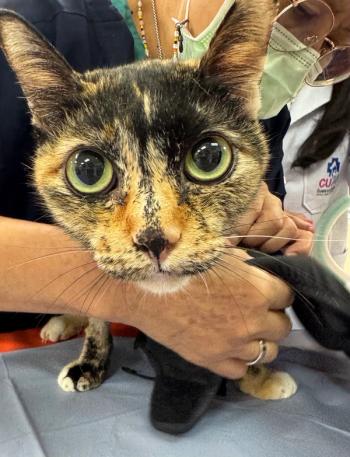
Diagnostic cardiology in the exam room (Proceedings)
Determine age, breed, and sex of the patient to help formulate a rule-out list and help to determine prognosis. Note current pre-existing diseases. Record current drugs and clinical response. Record presenting clinical signs and duration and progression of the illness.
History
Determine age, breed, and sex of the patient to help formulate a rule-out list and help to determine prognosis. Note current pre-existing diseases. Record current drugs and clinical response. Record presenting clinical signs and duration and progression of the illness.
Physical Examination
In addition to a complete physical examination, perform a thorough cardiovascular examination including all of the following:
1. Auscultation, noting:
a. Heart rate
b. Presence or absence of the following:
i. Heart murmur (Point of maximum intensity, radiation, loudness, timing, character)
ii. Gallop sound (rhythm)
iii. Other abnormality heart sounds (e.g. splitting of S1 or S2, clicks, rubs)
iv. Arrhythmias
v. Abnormal lung sounds
2. Femoral Pulse palpation (character, rate, rhythm, pulse deficits)
3. Jugular vein observation for distention or pulsation
4. Precordial palpation for apical impulse, presence of thrills
5. Abdominal palpation to assess organomegaly and detect ascites
Electronic Stethoscope
Electronic stethoscopes have improved dramatically in the past 10 years. This problem can be partially addressed by coupling the electronic stethoscope's chest piece to the chest wall with carefully applied ultrasound gel. In addition to electronic amplification of heart sounds and murmurs, most of the electronic stethoscopes currently allow the user to record and play back sounds at either normal or half speed, a useful feature for judging the timing and shape or quality of murmurs in tachycardic patients and for judging the timing of transient heart sounds such as clicks or gallops. Some models also provide the ability to record graphic representations of sounds in a digital file format (i.e., a phonocardiogram) that can be stored on a computer, possibly even becoming part of the patient's medical record. A new electronic stethoscope, the 3M Littmann model 3100 and 4100, features useful ambient noise reduction circuitry that appears to overcome most if not all of the problems of background noise amplification that plagued previous models. This stethoscope has the additional advantage of allowing wireless (infrared) digital file transfer to a computer, although this system currently has no provision for recording a timing ECG.
Electrocardiography
It is recommended that practitioners have two ECG machines: an oscilloscope and an electrocardiograph. The electrocardiograph linked with a strip recorder or printer provides a permanent record. A PC based system is highly recommended. The ECG is required for the accurate diagnosis of arrhythmias and conduction disorders. Just some of the indications include arrhythmias heard on auscultation, breathing problems, shock, fainting or seizures, cardiac murmurs, and systemic disease that affect the heart (tumors, kidney function, heartworm disease, etc.). The ECG is also useful as part of the preoperative work-up in older animals, for monitoring patients during and after surgery, and for evaluating the effects of cardiac drugs.
Assess the rate, rhythm and axis; evaluate to P-QRS-T complex morphology. The heart rate (beats/min) can be calculated easily by counting the number of beats (R-R interval intervals) between two sets of marks in the margin of the ECG paper (3 seconds at 25 mm/sec) and multiplying by 20. ECG rules are also available. This is all the measuring we need to do.
To recognize arrhythmias, you need to know two things:
1. The site of origin of the abnormal beat.
2. Recognize deviations from the normal rate of automaticity for that site.
Three different arrhythmias can be identified on Lead II by the following features:
• Atrial origin – these beats originate from somewhere in the atria other than the SA node. They look just like a normally conducted beat except that their timing is very early. A big hint is that the P-wave of the atrial beat touches the T-wave of the beat before it.
• Junctional origin – these beats originate near the AV node and have a negative deflection P-wave, or no P-wave, with a normally conducted, short-duration QRS complex.
• Ventricular origin – these beats originate somewhere in the ventricles. No P-waves are evident, QRS complexes are wide and bizarre appearing, and may be positive or negative polarity.
Blood Pressure
On a practical level, every veterinary practice should have a blood pressure unit, especially in feline medicine. Numerous studies in the veterinary literature show that a large percentage of cats more than 12 years of age have hypertension, either secondary to chronic renal disease or from underlying thyroid disease. A blood pressure monitoring device is critical for practitioners who see a large number of geriatric feline patients. Blood pressure should be recorded for cats with left ventricular hypertrophy of an unknown cause, cats with renal disease, cats with acute visual problems, and other critically ill patients.
References
Tilley, L.P., and Smith, F.W.K. (Eds): The Five Minute Veterinary Consult, 4th Edition. Baltimore, Lippincott, Williams & Wilkins, 2008.
Tilley, L. P.; Smith, F. W. K., Jr.: "Electrocardiography," Manual of Canine and Feline Cardiology, (eds.) L. P. Tilley et al., Fourth Ed., Ch. 3, pp. 49-77, Saunders Elsevier: St. Louis, Missouri (2008).
Knoll, J., Vaden, S; Smith, F.W.K.; & Tilley, L.P., (Editors): Lab Tests and Diagnostic Procedures-The 5 Minute Veterinary Consult – Canine and Feline, Wiley Blackwell Publishing, Ames, Iowa, 2009.
Newsletter
From exam room tips to practice management insights, get trusted veterinary news delivered straight to your inbox—subscribe to dvm360.






